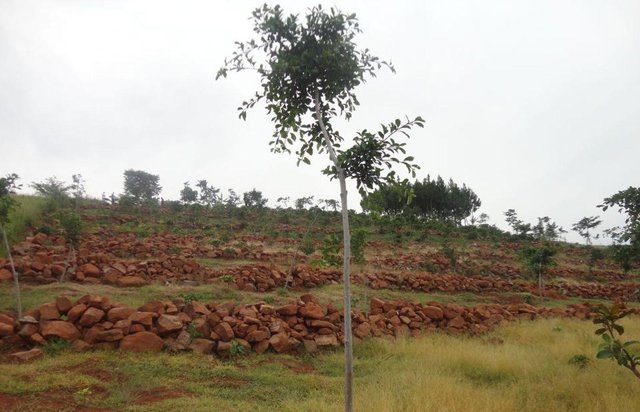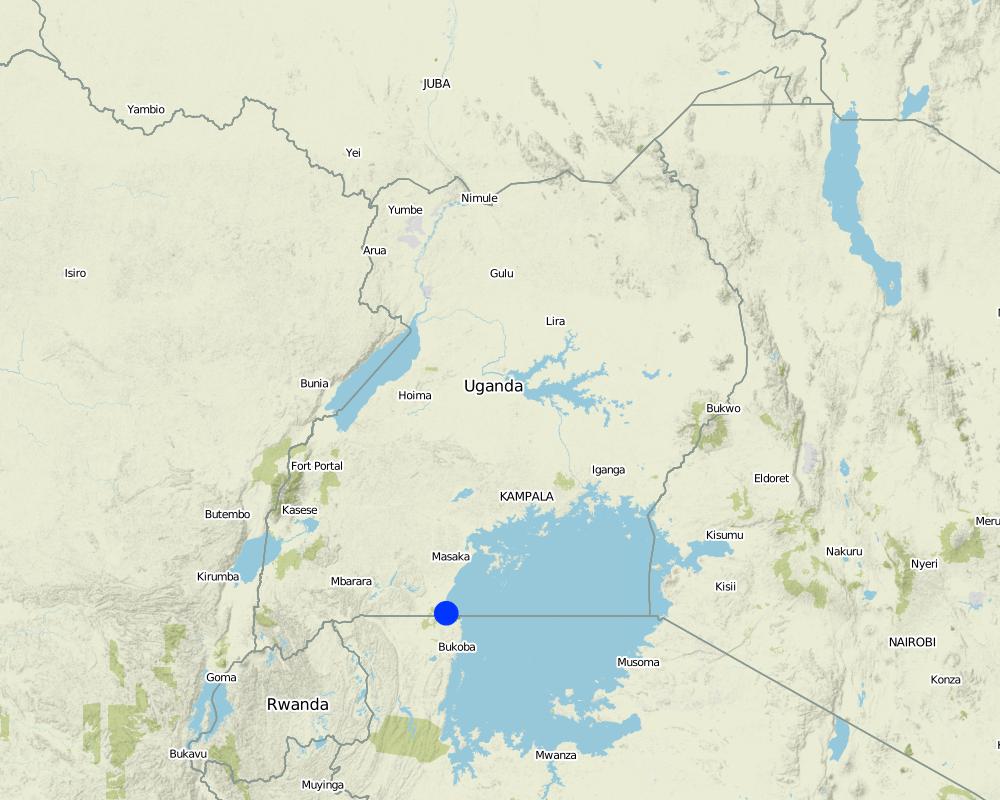FFS/SLM Community Initiative [Уганда]
- Создание:
- Обновить:
- Составитель: Wilson Bamwerinde
- Редактор: –
- Рецензент: Fabian Ottiger
Farmer Field School
approaches_2487 - Уганда
Просмотреть разделы
Развернуть все Свернуть все1. Общая информация
1.2 Контактные данные специалистов и организаций, участвующих в описании и оценке Подхода
1.3 Условия, регламентирующие использование собранных ВОКАТ данных
Когда были собраны данные (на местах)?
13/12/2013
Составитель и ответственный/-ые специалист(-ы) согласны с условиями, регламентирующими использование собранных ВОКАТ данных:
Да
1.4 Ссылка (-и) на Анкету (-ы) по Технологиям УЗП

Stone lines [Уганда]
Stone lines are built along a contour to control soil erosion on a degraded steep slope.
- Составитель: Wilson Bamwerinde
2. Описание Подхода УЗП
2.1 Краткое описание Подхода
Farmers are organized to promote adoption of sustainable land management best practices within the community
2.2 Подробное описание Подхода
Подробное описание Подхода:
Aims / objectives: To train farmers in land based technologies that improve productivity, land management and are resilient to climate changes
Methods: Planning meetings, agro-ecosystem analysis (AESA), farmer-to-farmer visits, monitoring and evaluation
Stages of implementation: Farmer Field School (FFS) formation to bring together 30 farmers from a catchment area; training in group dynamics; training in best practices to address land degradation problems; AESA; and action planning
Role of stakeholders: District facilitators: Facilitation of FFS formation, training of trainers for AESA, drawing village land use plans, prioritizing enterprises/challenges, making technical recommendations; Local leaders: Passing and implementing bye-laws.
2.5 Страна/ регион/ место, где применялся Подход
Страна:
Уганда
Административная единица (Район/Область):
Uganda
Более точная привязка места:
Kijonjo, Katongero, Rakai District
Map
×2.6 Даты начала и окончания реализации Подхода
Год начала реализации:
2011
Год окончания (Если Подход больше не применяется):
2015
2.7 Тип Подхода
- в рамках проекта/ программы
2.8 Каковы цели/ задачи Подхода
The Approach focused on SLM only (Sustainable Land Management Farmer Cooperative)
To share knowledge, skills and information on establishment of local best practices to improve productivity and biodiversity and reduce soil erosion
The SLM Approach addressed the following problems: Low soil nutrient levels, vegetation loss and soil erosion on steep slopes
2.9 Условия содействующие применению Технологии/ Технологий в рамках Подхода или затрудняющие его
Наличие/ доступность финансовых ресурсов и услуг
- затрудняют
Inadequate resources because farming is mainly subsistent
Treatment through the SLM Approach: Farmers formed cooperatives to pool resources
Осведомленность в области УЗП, доступность технической поддержки
- затрудняют
Little available information on addressing land management issues
Treatment through the SLM Approach: Trained facilitators were sourced to provide appropriate knowledge to address relevant constraints
Объем работ, доступность рабочей силы
- затрудняют
Increased workload required in the implementation caused expenses on hired labor to rise.
Treatment through the SLM Approach: Sharing workload through working together to dig up stones and carry them on steep slopes, lay them along contours and plant Ficus natalensis to stabilize the soil
3. Участие и распределение ролей заинтересованных сторон
3.1 Заинтересованные стороны, участвующие в реализации Подхода и их роли
- местные землепользователи/ местные сообщества
Women constitute the majority of farmers in attendance because most agricultural production in the district is carried out by women, except in cattle-keeping areas where men are the majority
- эксперты по УЗП/ сельскому хозяйству
- местные власти
District facilitators were provided by the district local government
- государственные власти (отвечающие за планирование или принятие решений)
Collaboration with the line Central Government Ministries through the Project Steering Committee at Permanent Secretary level
- международные организации
Kagera TAMP (FAO-GEF) provided funding for specialist facilitators
Если участвовало несколько заинтересованных сторон, назовите ведущую организацию:
Kagera TAMP international specialists with the help of national FFS specialists
3.2 Участие местных землепользователей/ местных сообществ на разных стадиях реализации Подхода
| Участие местных землепользователей/ местных сообществ | Перечислите участников и опишите их вовлеченность | |
|---|---|---|
| инициирование/ мотивация | интерактивное | FFS specialist facilitator with prospective FFS members to get farmers organized in FFS (30 members each) |
| планирование | интерактивное | Farmers in their farmer field schools sketched watershed maps and developed action plans with the help of district facilitators |
| выполнение | интерактивное | Facilitators helped FFS members in the dynamics that sustained and strengthened the Approach |
| мониторинг/ оценка | пассивное | A few members were co-opted to the monitoring team which comprised local government facilitators, Kagera TAMP Project specialists and the central government Project Steering Committee |
| Research | интерактивное | FFS members carried out Agro-ecosystem Analysis (AESA) with training and field support from specialists |
3.4 Принятие решений по выбору Технологии/ Технологий УЗП
Укажите, кто принимал решение по выбору применяемой Технологии/ Технологий:
- в основном землепользователи при поддержке специалистов по УЗП
Поясните:
The FFS concept and methodology were introduced to the farmers by SLM specialists. The decisions on technology choice were the result of discussions bf the farmers with support from the specialists.
Decisions on the method of implementing the SLM Technology were made by mainly by land users supported by SLM specialists. Farmers in the FFS decided how to overcome constraints posed by their hilly terrain and high cost of labor
4. Техническая поддержка, повышение компетенций и управление знаниями
4.1 Повышение компетенций/ обучение
Проводилось ли обучение землепользователей/ других заинтересованных лиц?
Да
Укажите, кто проходил обучение:
- землепользователи
- местный персонал/консультанты
- Politicians/Policy Makers
Тип обучения:
- в ходе работы
- обмен опытом между фермерами
- опытные участки
- общие собрания
Рассматриваемые темы:
Extension Training: use of demonstration plots and AESA to experiment and discover the appropriate methodology for implementation of SLM technologies. A formal session involves a facilitator and farmers. The facilitator guides the farmers on how to investigate a problem using marker-drawn sketches on flip chart. Observations, conclusions and recommendations are reached in a participatory manner.
Extension: FFS members adopt a resolution to carry out the recommended procedures/activities; community members are free to interact with FFS members on field days and copy recommendations. Farmer-to-farmer visits are encouraged and promoted to extend information.
Research: FFS members research together on a given problem/challenge such as soil fertility and arrive at recommendations together. They are guided by facilitators from government or government research institutions with collaborative support from Kagera TAMP/FAO project.
Importance of land use rights: Ownership of land affects land management practices. The attitude towards the recommendation by farmers is usually determined by the FFS members. In Kagera TAMP districts land ownership is customary but the right to use land is governed by national laws.
Incentives:
Labor: Farmer Field School members provide the labor to implement technologies. Hired labor may also be used.
Inputs: Farmers provide the basic tools such as hoes, pick axe etc. Seedlings and seeds may be provided by the project.
Credit: Small amounts may be acquired from the FFS cooperative savings.
4.3 Институциональная (организационная) поддержка
В ходе реализации Подхода были ли организованы новые институциональные структуры или поддержаны уже существующие?
- да, существенно
Укажите уровень, на котором структуры были укреплены или вновь созданы:
- местные
Укажите тип поддержки:
- повышение компетенций/ обучение
- оборудование
Подробнее:
Training workshops in Sustainable Land Management (SLM) and Land Degradation Assessment (LADA) both national and international, seminars, and procurement and training in the use of computers, digital cameras and GPS units
4.4 Мониторинг и оценка
Являются ли мониторинг и оценка частью Подхода?
Да
Комментарии:
bio-physical aspects were regular monitored by project staff, government, land users through observations; indicators: Measurement of crop yield, soil nutrients, biodiversity
bio-physical aspects were regular monitored by project staff, government, land users through measurements; indicators: Measurement of crop yield, soil nutrients, biodiversity
economic / production aspects were regular monitored by government, land users through observations; indicators: Measurement of crop yield, vigor
economic / production aspects were regular monitored by government through measurements; indicators: Measurement of crop yield, vigor
area treated aspects were regular monitored by project staff, government through observations; indicators: Measure by attendance, morale
area treated aspects were regular monitored by project staff, government through measurements; indicators: Measure by attendance, morale
no. of land users involved aspects were regular monitored by project staff through observations; indicators: None
no. of land users involved aspects were regular monitored by project staff through measurements; indicators: None
management of Approach aspects were None monitored by project staff through observations; indicators: None
management of Approach aspects were None monitored by project staff through measurements; indicators: None
There were few changes in the Approach as a result of monitoring and evaluation: FFS constantly refines and improves on what and how to achieve objectives, to discover and archive best practices in the most effective forms possible
There were few changes in the Technology as a result of monitoring and evaluation: Height of stone lines, width between lines
4.5 Научные исследования
Были ли научные исследования частью Подхода?
Да
Укажите темы исследований:
- экология
Напишите подробнее и назовите тех, кто выполнял исследования:
Agro-ecosystem Analysis (AESA) by FFS members
Research was carried out on-farm
5. Финансирование и внешняя материальная поддержка
5.1 Годовой бюджет мероприятий по УЗП в рамках Подхода
Если точный годовой бюжет неизвестен, укажите примерный диапазон затрат:
- < 2000
Комментарий (например, основные источники финансирования/ ключевые доноры):
Approach costs were met by the following donors: international (Kagera TAMP): 18.95%; local government (district, county, municipality, village etc) (District and Sub-county facilitator time): 11.14%; local community / land user(s) (Land users as FFS members): 69.91%
5.2 Финансирование и внешняя материальная поддержка, предоставляемая землепользователям
Предоставлялась ли землепользователям финансовая/ материальная поддержка для применения Технологии /Технологий?
Нет
5.3 Субсидии на отдельные затраты (включая оплату труда)
Если труд землепользователя был существенным вкладом, укажите, был ли этот вклад:
- добровольный
Комментарии:
FFS members were facilitated with information and they carried out the approach without any financial or material support
5.4 Кредитование
Предоставлялись ли в рамках Подхода кредиты на мероприятия УЗП?
Нет
6. Анализ влияния и заключительные положения
6.1 Влияние Подхода
Сумел ли Подход помочь землепользователям внедрить и поддерживать технологии УЗП?
- Нет
- Да, немного
- Да, умеренно
- Да, существенно
Formerly disused land was made productive
Did other land users / projects adopt the Approach?
- Нет
- Да, немного
- Да, умеренно
- Да, существенно
Did the Approach lead to improved livelihoods / human well-being?
- Нет
- Да, немного
- Да, умеренно
- Да, существенно
Crop diversification, food security
Did the Approach help to alleviate poverty?
- Нет
- Да, немного
- Да, умеренно
- Да, существенно
FFS savings and credit cooperative helping members to access small unsecured agro-input financing
6.2 Основные причины, побуждающие землепользователей внедрять УЗП
- рост продуктивности
- рост прибыли (доходности) и рентабельности
- экологическая сознательность
6.3 Долгосрочная устойчивость мероприятий в рамках Подхода
Могут ли землепользователи самостоятельно (без внешней поддержки) продолжать применение того, что было реализовано в рамках Подхода?
- да
Ссылки и модули
Развернуть все Свернуть всеСсылки

Stone lines [Уганда]
Stone lines are built along a contour to control soil erosion on a degraded steep slope.
- Составитель: Wilson Bamwerinde
Модули
Нет модулей


